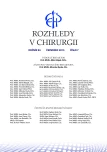Pruritus ani
Authors:
M. Lerch 1; M. Peteja 1,2
; P. Ihnát 1,2; I. Lerchová 3; A. Zatloukal 1; P. Zonča 1,2
Authors‘ workplace:
Chirurgická klinika FN Ostrava, přednosta: doc. MUDr. P. Zonča, Ph. D., FRCS
1; Lékařská fakulta, Ostravská univerzita, děkan: doc. MUDr. P. Zonča, Ph. D., FRCS
2; Gastroenterologické oddělení, Městská nemocnice Ostrava, primář: MUDr. M. Kremer
3
Published in:
Rozhl. Chir., 2015, roč. 94, č. 7, s. 269-275.
Category:
Review
Overview
Introduction:
Pruritus ani is defined as a dermatologic disease characterized by itching and/or burning in the perianal area. It occurs in 1−5% of the population. Men are affected more frequently than women, in the ratio 4:1. It is accompanied by an irresistible desire to scratch in the perianal area. Pruritus ani is divided into two subtypes: primary (idiopathic) and secondary. In idiopathic (primary) pruritus it is not possible to detect any other cause of itching. Secondary pruritus has an obvious causal origin.
The aim of this paper is to offer a complex overview of possible causes, diagnostic procedures and treatment possibilities of this unpleasant and annoying disease.
Methods:
We have researched available publications using PubMed and MEDLINE databases, focusing on articles on anal pruritus. At first the key word “Pruritus ani” was put in without any restrictions. Subsequently, we limited the selection by the time period of 5 years and 10 years; then we looked up articles in English, German and Czech languages, and finally review articles, clinical trials and others.
Results:
574 articles were found without entering any restrictions; 45 of them were review articles and 25 clinical trials. 437 articles were in the English language and 40 of them were review articles. 44 were in the German language and 1 of them was a review article. A total of 33 articles were found with a 5-year time limit. 6 of them were review articles and 4 were clinical trials. 66 articles from the last 10 years were found. 14 of them were review articles and 10 were clinical trials. In most of the other articles among the total number of articles found, pruritus ani was mentioned only marginally in articles focused on different topics. We have not found any summary articles on this topic in Czech publications.
Conclusion:
Pruritus ani is a common disease with a number of causes; therefore, effective treatment may be insufficient in the initial stages. The therapy is focused on the primary cause, if found. Broad differential diagnosis options need to be taken into consideration, and reevaluation of the therapy is a priority. When no obvious secondary cause is found, the empiric treatment is focused on an improvement of hygiene and change in the life style, removal of common irritators, and protection of perianal skin.
Key words:
pruritus ani − primary − secondary − itch − treatment
Sources
1. Nasseri Y, Osborne M. Pruritus ani: diagnosis and treatment. Gastroenterol Clin N Am 2013;42:801−13.
2. Siddiqi S, Vijay V, Ward M, et al. Pruritus ani. Ann R Coll Surg Engl 2008;90: 457−63.
3. Song S, Kim S. Pruritus ani. J Korean Soc Coloproctol 2011;27:54−7.
4. Henderson P, Cash B. Common anorectal conditions: evaluation and treatment. Curr Gastroenterol Rep 2014;16:408.
5. MacLean J, Russel D. Pruritus ani. Aust Fam Physician 2010;39:366−70.
6. Caplan RM. The irritant role of reces in the genesis of perianal tich. Gastroenterology 1966;50:19−23.
7. Twycross R, Greaves MW, Handwerker H, et al. Itch: scratching more than the surface. QJM 2003;96:7−26.
8. Ringkamp M, Schepers R, Schimada S, et al. A role for nociceptive myelinated nerve fibres in tich sensation. J Neurosci 2011;31:14841−9.
9. Laurent A, Boucharlat J, Bosson JL, et al. Psychological assessment of patiens with idiopathic pruritus ani. Psychoter Psychosom 1997;66:163−6.
10. Friend WG. The cause and treatment of idiopathic pruritus ani. Dis Colon Rectum 1977;20:40−2.
11. Smith LE, Hennrichs D, Mc Cullah RD. Prospective studies on the ethiology amd treatment of pruritus ani. Dis Colon Rectum 1982;25:358−63.
12. Allan A, Ambrose NS, Silverman S, et al. Physiological study of pruritus ani. Br J Surg 1987;74:576−9.
13. Farouk R, Duthie GS, Pryde A, et al. Abnormal transient internal sphincter relaxation in idiopathic pruritus ani: physiological evidence from ambulatory monitoring. Br J Surg 1994;81:603−6.
14. Eyers AA, Thomson JP. Pruritus ani: is anal sphincter dysfunction important in etiology? BMJ 1979;2:1549−51.
15. Daniel GL, Longo WE, Vernava AM 3rd. Pruritus ani. Causes and concerns. Dis Colon Rectum 1994;37:670−4.
16. Sauer T. The role of the bidet in pruritus ani. Aust Fam Physician 2010;39:715.
17. Hanno R, Murphy P. Pruritus ani: classification and management. Dermatol Clin 1987;5:811−6.
18. Lysy J, Sistiery-Ittah M, Israelit Y, et al. Topical capsaicin − a novel and effective treatment for idiopathic intractable pruritus ani: A randomised, placebo controlled, crossover study. Gut 2003;52:1323−6.
19. Botterill ID, Sagar PM. Intra-dermal metylene blue, hydrocortisone and lignocaine for chronic, intractable pruritus ani. Colorectal Dis 2002;4:144−6.
20. Mentes BB, Akin M, Leventoglu S, et al. Intradermal metylene blue injection for the treatment of intractable idiopathic pruritus ani: results of 30 cases. Tech Coloproctol 2004;8:11−4.
21. Sutherland AD, Faragher IG, Frizelle FA. Intradermal injection of metylene blue for the treatment of refractory pruritus ani. Colorectal Dis 2009;11:282−7.
22. Zuccati G, Lotti T, Mastrolorenzo A, et al. Pruritus ani. Dermatol Ther 2005;18:355–62.
Labels
Surgery Orthopaedics Trauma surgeryArticle was published in
Perspectives in Surgery

2015 Issue 7
- Metamizole vs. Tramadol in Postoperative Analgesia
- Metamizole at a Glance and in Practice – Effective Non-Opioid Analgesic for All Ages
- Current Insights into the Antispasmodic and Analgesic Effects of Metamizole on the Gastrointestinal Tract
Most read in this issue
- Pruritus ani
- SentiMag – the magnetic detection system of sentinel lymph nodes in breast cancer
- Heterotopic mesenteric ossification
- Endoscopic endonasal treatment of cerebrospinal fluid leak caused by clival fracture – a case report
